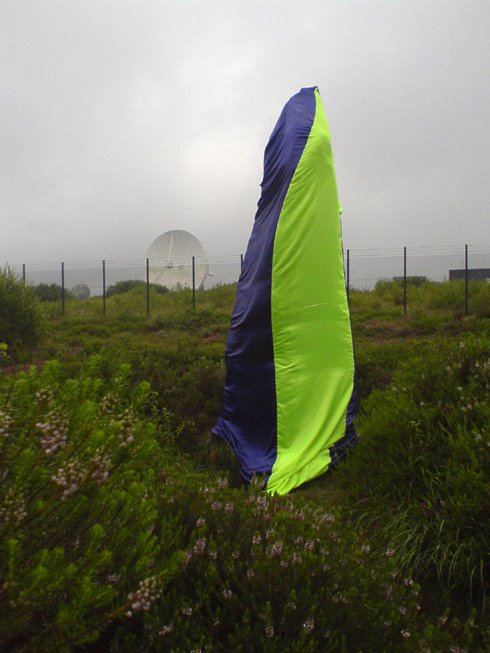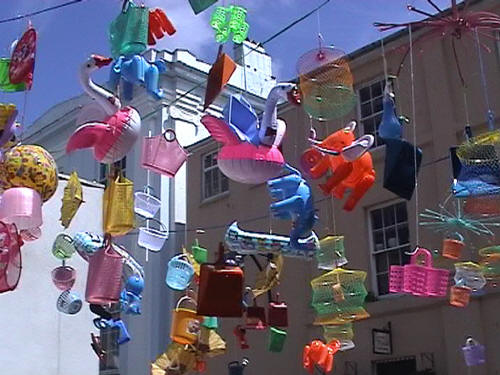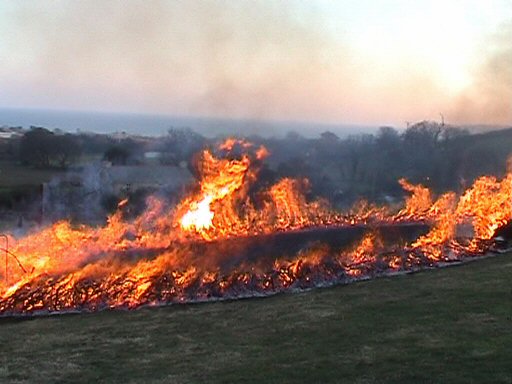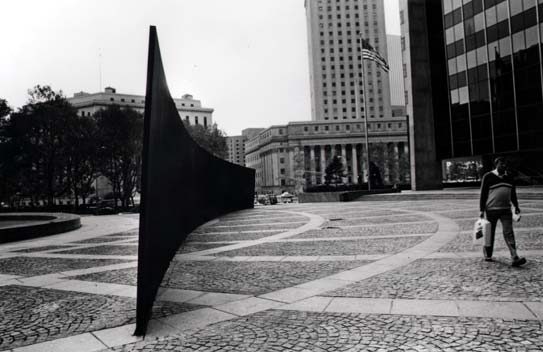|
|
| home | exhibitions | interviews | features | profiles | webprojects | archive |
|
More v Social Systems: a response to Virginia Button Rupert White
During Summer 2007, Projectbase curated 'Social Systems', an event in which six international artists were invited to show in the three big public galleries in Penwith, as well as in a variety of settings ‘in the public realm’. Simultaneously, 'more' Cornwall took place. 'More' was an artist-led initiative in which over 30 local artists created work for a variety of venues across the county, from Tresco in the Scillies to County Hall in Truro.
At a personal level the organisers of 'more' and Social Systems were well acquainted, and there were many similarities between the two projects. For example, both could be viewed as predominantly ‘site-specific’ in some way. Yet they were also very different. 'more' was, in a common-sense way, embedded into a local art-scene and the communities that are contiguous with it. In contrast, Social Systems was intent on casting doubt on any such conventions regarding ‘the local’ and ‘the community’, by replacing them with an exotic form of global art that travels freely, or attempts to travel freely, across international boundaries. In going against commonsense ideas of community, and proposing forms of discursive or virtual community in their stead, Social Systems took more risks, and in the process seemed willing to stretch the credulity of its audience almost to breaking point. Issues such as community and globalisation are immensely important, yet intellectually complex, and they form debates at the heart of our social and cultural fabric. Whilst 'more' Cornwall did not have a programme, or mission statement as such, Virginia Button addressed some of the complexities raised in the essays she wrote for the Social Systems catalogue which were typically concise and eloquent. And although she went a long way to work through some of the superficial tensions highlighted by the Social Systems project, her essays also exposed other, deeper, areas of conflict. ‘Scattered site exhibitions in predominantly rural areas tend to exploit remote picturesque locations. By contrast Social Systems deliberately takes place in some of Cornwall’s urban centres…focussing attention on the often overlooked landscape of Cornwall’s human networks…..The artists represented have undertaken research, dialogue and collaboration with local communities’ ‘They (social systems artworks) invite consideration of place as something other than might be expected…provide catalysts for public discussion of how we live our lives in this and other places, and how lives in different places around the world are…interlinked’
‘Cornwall for many people appeals to a
nostalgic longings for a fixed sense of location and of coherent rooted
community, a kind of ballast against uncontrollable technologically
driven acceleration…..Attachment to place as defined by geography or
physical attributes is – regrettably - out of synch with the prevalent
description of contemporary life as a network of unanchored flows’ Concealed within these fascinating quotes are strands of thinking which are increasingly accepted within dominant cultural discourse, and which in this case are being deployed by a highly respected local art-writer, to explain an interesting and challenging exhibition by non-local artists. One, and probably the most significant theme that emerges in these essays and countless others, is the implication that identifying with the picturesque (or with the landscape) is false, wrong or inauthentic. It is this view in particular which, when it appears, seems to betray an urban-centric bias and an assumption that the reader lives e.g. in London. Of course attachment to a place by virtue of its landscape or geography seems hugely anachronistic if you live in Peckham or Shoreditch: yet the experience of culture and its relationship to the landscape as an inhabitant of Cornwall – or similar decentred periphery - is different. And it does not have to be sentimental, nostalgic or inauthentic. Cornwall is the most diffusely populated county in the country, and its towns are market towns serving predominantly rural communities. Most of the people of Cornwall live near the sea or areas of uncultivated land. Cornwall, was never properly industrialised and has never become fully urban. Because of this most residents of Cornwall define themselves to some degree by a view they have of the sea e.g. from their living room, or from some other similar internalised representation of the landscape, such as a favourite beach or cliff-walk. This self-identity with the landscape is difficult to measure or verify, but for Cornwall as for similar rural areas the landscape remains its best asset and its defining feature. Because of this, it is therefore also a unifying and shared symbol for the communities that partake of it. There are other more tangible ways in which the landscape actively shapes cultural experience – quite apart from its role in relation to tourism, farming and industry. Leisure activities like walking dogs on the beach, surfing, walking, sailing and boating, as well as contributing to a self-identity, are also social activities that actively create communities through the landscape itself acting as a physical intermediary.
In much art-writing sophisticated urban-centric arguments are, however, often used in order to clear the way for a 'corporate takeover' by a particular form of contemporary international art, made by artists who wander the globe, plying their trade for whoever will buy their services, making and remaking the same works in different locations. I use the analogy of the ‘corporate take-over' because there is an unfortunate sense in which the international artist has become another global commodity: like Costa Coffee or Starbucks, like Hollywood films or well-known clothes brands, which are instantly recognisable. Theoretically, by virtue of the strength of their branding and marketing (the money that backs the brand) they are able to colonise large parts of the planet accelerating, in the process, both globalisation and capitalism. Such a process destroys cultures as we know them. It erases local differences, in order to enlarge the field in which national corporations can operate. Coming back to art, Button goes on to quote from ‘One place after the other’ by Miwon Kwon. Kwon's book, which is explicitly about the condition of contemporary public urban art, takes as its exemplars Richard Serra’s Titled Arc and Culture in Action:
‘Although sympathetic with the widely held view that the erosion of
local differences by the expansion of capitalism has contributed to a
loss of identity and a growing sense of alienation, Kwon recognises that
any desire to return to a by-gone and determinedly anti-urban sociality
is itself equally open to appropriation by capitalist forces which
thrive on the production of difference. The marketing of the rural idyll
to wealthy second-homers and urban refugees…is a case in point’ I would question the idea that people in Cornwall, or other remote rural areas, are already partaking in a fully urban ‘sociality’, and that aspiring to anything else is a backward return to a bygone age. Or put another way I object to the possibility that, as producers of culture, it is no longer possible, perhaps through a form of radical ruralism, to question, critique or resist the processes by which Western societies become urbanised, and culture becomes globalised. In fact it is debatable where Kwon stands in relation to this issue. Kwon’s book is about the predicament of the urban artist: and the way in which public art placed in urban spaces has become more responsive to the communities that are exposed to it; in contrast to e.g. Serra's Tilted Arc (above) which was very unpopular with the public. Working with communities in cities is the best way to make the art 'stick', and to make it relevant, because the urban space, perhaps through the forces of modernism, has become so generic and impersonal, and empty of stories and narrative. Kwon, however, is quite careful to not be drawn on the question e.g. of Land Art and art made in rural environments and with rural communities in mind. I would argue this is because a different set of rules apply. In the end it is probably the discourse itself (the one that e.g. refers to nostalgia, sentiment and bygone ages), that risks being dismissive of the experience of the local, and of the landscape as a real lived environment. I would argue that it is a mind-set that threatens to deny difference and homogenise cultural values, realigning them in a way that fits with an urban lifestyle but remains at odds with the daily experience of rural communities. In fairness, to Virginia Button, hers is a very moderate, considered, and sensitively-handled version of that discourse, and one that I have selectively quoted and possibly misread or misunderstood. In addition it should also be said that I am grateful to her for bringing into focus some of these issues in the first place. It remains true in general terms, however, that urban-centric cultural discourse and art practice in general, threatens to sideline the question of our relation to the landscape, and the experience of rural living, at a time when, due to impending environmental disaster these issues becomes more, not less, important. As artists, writers and cultural producers living and working in a marginalised rural environment it is important that we recognise and value that which is special about our lives and lifestyles, and forcefully challenge implications from within and without, e.g. that rural art and culture is backward, passé or sentimental. Instead we should be recognising, seizing and developing that which is most radical and challenging about it. If there was one way in which 'more' succeeded where Social Systems failed it was in attempting to do just this.
Rupert White, the author, was a contributor to 'more' but does not speak for the other artists who were involved with it. RW 28/9/07
|
|
|



 So
in rural areas the sense that communities can best be located or defined
in virtual or discursive arenas away from the landscape is not only
counter-intuitive, but patently false.
So
in rural areas the sense that communities can best be located or defined
in virtual or discursive arenas away from the landscape is not only
counter-intuitive, but patently false.